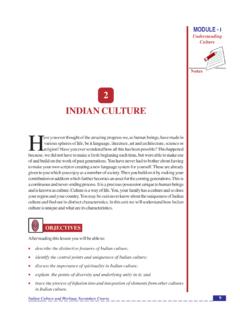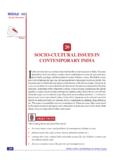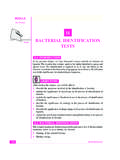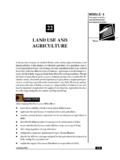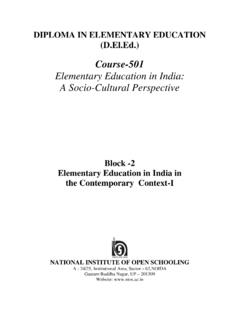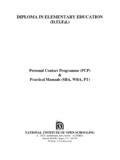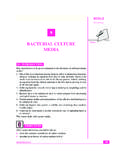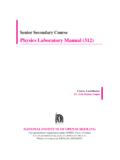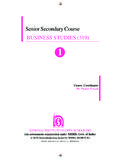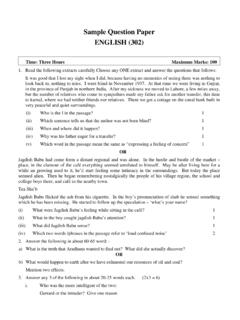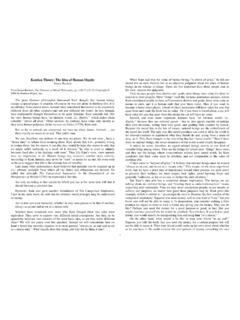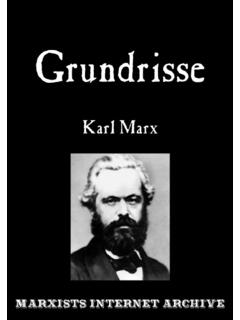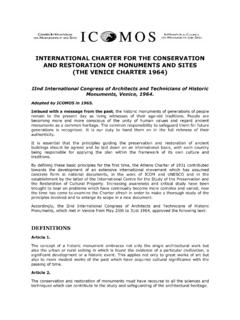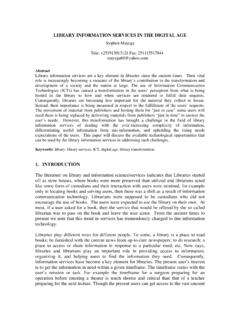Transcription of MATHEMATICS (3 11)
1 Senior Secondary Course MATHEMATICS (311). 1. Course Coordinator Dr. Rajendra Kumar Nayak NATIONAL INSTITUTE OF OPEN SCHOOLING. (An Autonomous Organisation under MHRD, Govt. of India). A-24/25, Institutional Area, Sector -62, Noida -201309. Website: , Toll Free ADVISORY COMMITTEE. Dr. Jena Dr. Kuldeep Agarwal Dr. Rachna Bhatia Chairman Director (Academic) Asst. Director (Academic). NIOS NIOS NIOS. CURRICULUM COMMITTEE. Prof. G. Ravindra Prof. Mohan Lal Prof. Arun Kapur Director (Retd.) Principal (Retd.) Professor (Retd.). NCERT, New Delhi PG DAV College Dept. of Maths Nehru Nagar, New Delhi Jamia Milia Islamia University, New Delhi Prof. Shukla Prof. Gupta Prof. Chauhan Dept. of Maths Dept. of Measurement Dept. of Education Lucknow University & Evaluation, NCERT, Aligarh Muslim Univresity Lucknow. New Delhi Aligarh. Sh. Dhall Sh. Nijhawan Dr. Rajendra Kumar Nayak Reader (Retd.) Vice Principal (Retd.) Academic Officer ( MATHEMATICS ). NCERT, N. Delhi Govt. Boys Sr.
2 Sec. School NIOS. Keshav Puram, N. Delhi LESSON WRITERS. Prof. Gupta Sh. Garg Sh. Anand Dept. of Measurement Principal (Retd) Principal (Retd.). & Evaluation, NCERT, Ramjas Sr. Sec. School DAV Centenary, Public School, New Delhi Anand Parvat, N. Delhi Pachim Enclave, New Delhi Sh. Nijhawan Sh. Sharma Sh. Sharma Vice Principal (Retd.) PGT (Maths) Vice-Principal Govt. Boys Sr. Sec. School Govt. Boys Sr. Sec. School Navodaya Vidyalaya Samiti (NVS). Keshav Puram, N. Delhi Sarojini Nagar, New Delhi Mungespur, NewDelhi Dr. Singh Dr. Satyavir Singh Dr. Rajendra Kumar Nayak Lecturer Principal, SNI College Academic Officer ( MATHEMATICS ). RPVV, Gandhi Nagar, Pilana ( ) NIOS. New Delhi EDITORS. Sh. Nijhawan Sh. Garg Sh. Sharma Vice Principal (Retd.) Principal (Retd) Vice-Principal Govt. Boys Sr. Sec. School Ramjas Sr. Sec. School Navodaya Vidyalaya Samiti (NVS). Keshav Puram, N. Delhi Anand Parvat, N. Delhi Mungespur, New Delhi Dr. Singh Dr. Satyavir Singh Dr. Rajendra Kumar Nayak Lecturer in Maths Principal, SNI College Academic Officer ( MATHEMATICS ).
3 RPVV, Gandhi Nagar, Pilana ( ) NIOS. COURSE COORDINATOR. Dr. Rajendra Kumar Nayak Academic Officer ( MATHEMATICS ). NIOS. GRAPHIC DESIGNANDTYPE SETTING. Afsar Graphic : Gali Shahtara, Ajmeri Gate, Delhi-6 (09811475852). Graphic Artist : MS Computer Patparganj, New Delhi- Chairman's Message Dear learner, As the needs of the society in general, and some groups in particular, keep on changing with time, the methods and techniques required for fulfilling those aspirations also have to be modified accordingly. Education is an instrument of change. The right type of education at right time can bring about positivity in the outlook of society, attitudinal changes to face the new/fresh challenges and the courage to face difficult situations. This can be very effectively achieved by regular periodic curriculum renewal. A. static curriculum does not serve any purpose, as it does not cater to the current needs and aspirations of the individual and society. For this purpose only, educationists from all over the country come together at regular intervals to deliberate on the issues of changes needed and required.
4 As an outcome of such deliberations, the National Curriculum Framework (NCF 2005). came out, which spells out in detail the type of education desirable/needed at various levels of education primary, elementary, secondary or senior secondary? Keeping this framework and other national and societal concerns in mind, we have currently revised the curriculum of MATHEMATICS course at senior secondary level, as per the Common Core Curriculum provided by National Council of Educational Research and Traning (NCERT) and the Council of Boards of School Education in India (COBSE) making it current and need based. Textual material production is an integral and essential part of all NIOS programmes offered through open and distance learning system. Therefore, we have taken special care to make the learning material user friendly, interesting and attractive for you. I would like to thank all the eminent persons involved in making this material Interesting and relevant to your needs.
5 I hope you will find it appealing and absorbing. On behalf of National Institute of Open Schooling, I wish you all a bright and Successful future. (Dr. S. S. Jena). Chairman, NIOS. A Note from the Director Dear Learner, The Academic Department at the National Institute of Open Schooling tries to bring you new programmes every now and then in accordance with your needs and requirements. The MATHEMATICS course at Senior Secondary level has now been revised as per the Common Core Curriculum developed by COBSE (Council of Boards of School Education) and NCERT (National Council for Educational Research and Training). making it current and need based. The National Curriculum Framework developed by the National Council for Educational Research and Training was kept as a reference point. Leading experts in the subject of the country were involved and with their active involvement, study materials based on the new curriculum have been updated. Old, outdated information has been removed and new, relevant things have been added.
6 I am happy to place this new revised study material in Senior Secondary MATHEMATICS in your hand. I hope you will find the new material that is now in your hands interesting and exciting. Any suggestions for further improvement are welcome. Let me wish you all a happy and successful future. (Dr. Kuldeep Agarwal). Director (Academic), NIOS. Letter to Learner Dear Learner, I welcome all of you to the Senior Secondary course in MATHEMATICS . It gives me a great pleasure that you have opted for MATHEMATICS as one of your subjects of study. Study of MATHEMATICS contributes to the development of precision, rational and analytical thinking, reasoning and scientific temper. These qualities, no doubt, are essential for success in life, whatever career you choose. MATHEMATICS is important fields in many professions like- Engineering, Architecture, Statisticians, Commerce and Accountancy related profession, Econometrics etc. The present curriculum in MATHEMATICS has been divided into two Parts.
7 Part-1 contains 19 Lessons under five modules. These modules are Sets, Relations and Functions; Sequences and Series; Algebra-I; Co-ordinate Geometry; and Statistics &. Probability. Similarly Part-2 contains 19 Lessons from five modules. These modules are Algebra-II; Relations and Functions; Calculus; Vectors and Three Dimensional Geometry;. and Linear Programming & Mathematical Reasoning. All efforts have been made to give related illustrations and examples for your better understanding. You should go through all solved examples and try to solve all problems under Check Your Progress and Terminal Exercise independently given at the end of each lesson. If you face any difficulty, please do not hesitate to write to me. Your suggestions and doubts are most welcome. Wish you a bright future. Yours, Dr. Rajendra Kumar Nayak Academic Officer ( MATHEMATICS ), NIOS. MATHEMATICS IN INDIA. MATHEMATICS is considered to be a system of logic. It is the subject of systematic study of quantitative phenomena around us.
8 It is based on certain logical connotation of numbers and integral part of human civilisation. MATHEMATICS is a creative activity and is one of the most useful, fascinating and stimulating divisions of human knowledge. It is a process of managing and communicating information and has the power to predict and provide solutions to practical problems as well as enabling the individual to create new imaginative worlds to explore. We use MATHEMATICS in everyday life, in science, in industry, in business and in our free time. MATHEMATICS education is concerned with the acquisition, understanding and application of skills. Mathematical literacy is of central importance in providing the learner with the necessary skills to live a full life as a child and later as an adult. Society needs people who can think and communicate quantitatively and who can recognize situations where MATHEMATICS can be applied to solve problems. It is necessary to make sense of data encountered in the media, to be competent in terms of vocational mathematical literacy and to use appropriate technology to support such applications.
9 The earliest traces of Mathematical knowledge in the Indian subcontinent appear right from the ancient period. The three main contributions in the field of MATHEMATICS were the notation system, the decimal system and the use of zero. Aryabhata worked on the place value system using letters to signify numbers. The most significant contribution of Indian Mathematicians were the introduction of zero (0) to the MATHEMATICS , which is understood as nothing . The concept itself was one of the most significant inventions in the ascent of humans for the growth of culture and civilization. Brahmagupta introduced negative numbers and operations on zero into MATHEMATICS . He wrote Brahm, Sputa Siddantika through which Arabs came to know them the Mathematical system. Bhaskaracharya otherwise known as Bhaskara-II was one of the most powerful and creative mathematicians of ancient India. He contributed the idea of infinity, negative numbers and Zero rules in the field of MATHEMATICS .
10 Baudhayan was the first one ever to arrive at several concepts in MATHEMATICS , which were later rediscovered by the western world. The value ofPi was first calculated by him. Pythagoras theorem is already found in Baudhayan's Sulvasutra, which was written several years before the age of Pythagoras. Mahaviraacharya another prominent Mathematician in India contributed on trigonometric functions and cubic equations. He described Fraction, algebraic equations, logarithms and exponents in a very interesting manner. Sridhar another highly esteemed Indian Mathematician who has contributed to the solution quadratic equation. Astronomy is the applied MATHEMATICS that used Mathematical equations to describe the universe or to predict various aspects of the universe. MATHEMATICS is and always has been of central importance to astronomy. In ancient India, Nagarjuna a famous astronomer as well as mathematician used different equations of MATHEMATICS to describe motion of stars and planets.
